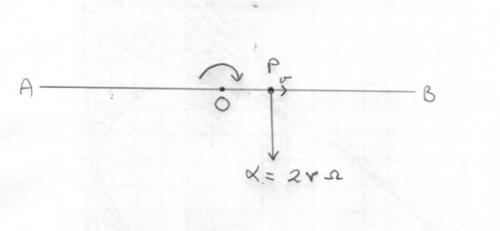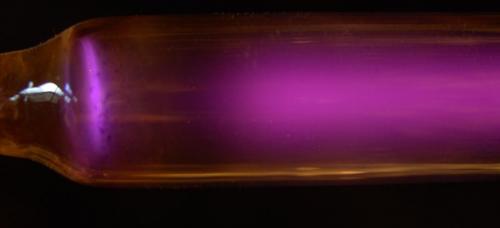-
Posts
18270 -
Joined
-
Last visited
-
Days Won
104
Content Type
Profiles
Forums
Events
Everything posted by studiot
-
Mike, you have actually made a clear and cogent point that I can understand. And a good point it is too. +1
-
Look up the solubilities of postassium and sodium sulphate https://en.wikipedia.org/wiki/Solubility_table
-
Actually it doesn't refer to anything unless you define your symbols. Stating an equation without doing this is unacceptable. Notice I defined all my symbols in my brief post. Actually it doesn't refer to anything unless you define your symbols. Stating an equation without doing this is unacceptable. Notice I defined all my symbols. Further I expected some kind of explanation/description of the physical system your equation models. Or do I have do guess at that as well?
-
No, it should however have prompted you to provide the full information about your scenario. I should not have to guess at it. A musical top huh? Consider this instead. A mass point P is moving with constant velocity v along line AB, as shown. At the same time the line AB is rotated with constant agular velocity [math]\Omega [/math] about centre O in the direction shown. P will be subject to an acceleration [math]2v\Omega [/math], again in the direction shown.
-
I think there must be some misunderstanding here (Nver suprising with Resnick and Halliday). Moment of momentum and Momentum may well refer to different things. A spinning top or ball has moment of momentum but zero momentum. A ball travelling in straight line, without rotating on its axis, has momentum but zero moment of momentum. A ball travelling around on a whirling string has both momentum and moment of momentum.
-
Perhaps a view from across the water? Ever since I was a small boy, (and I know the tradition goes back at least as far as the 19 century) we have had end of period (week, month, whatever) satirical offerings from the creative arts folks. Some are really good, some are plain trash. Often they are really cutting. Politics has become more personal and polarised in recent years and coupled with the acceleration of output there is bound to be an increase in the rubbish. We should remember the good and forget the bad, there will soon be a better joke available.
-

Speed of light independent of the source ?
studiot replied to Roger Dynamic Motion's topic in Classical Physics
Is that clear enough? -
Much better. +1
-

Speed of light independent of the source ?
studiot replied to Roger Dynamic Motion's topic in Classical Physics
Well I could think of circumstances in which that is true. But then I could think of circumstances in which it is untrue. But then you did not do what Janus asked. I would suggest you use several short sentences. Each sentence should contain only one statement. That would help you a great deal. -

Speed of light independent of the source ?
studiot replied to Roger Dynamic Motion's topic in Classical Physics
This is true of all waves. That is the speed of the wave is independent of the speed of the source. Light is no different in that respect. I would add that the big breakthrough by Einstein with regard to light was the proporition that the speed is also independent of the speed of the observer. The observed speed of other waves does depend upon the speed of the observer. However this forum is entitled classical physics. Did you really mean to put the question there? -
I did look at your examples and you totally ignored me, This was despite your replying to others, who were not actually addressing what your wrote. Fir the record most (including some of your posts which makes things confusing) replies seem to address the statement you did not make viz "Every truth is absolute". What you actually claimed was there is such a thing as absolute truth, and even gave a definition. It was that definition that is not matched by your example, given in the same paragraph,that I have challenged.
-
Presumably your experiment studied the effect of steadily evacuating the tube? More detail would have been helpful. Then you would have seen at higher pressures a continuous glow between the electrodes. As you reduce pressure to about 0.1mm of mercury the glow becomes striated (breaks up to glowing and dark bands). These bands are not all of the same size. There is one quite large one near the cathode called the Faraday dark space, shown in the picture. Another large one is the Crookes dark space. As you reduce the pressure further the gaps become larger and the glow zones smaller. until, in your case your reach a point where the pressure is so low that the gaps overtake the glow zones. Now since this presumably coursework you want to know why. So think about the question What glows? And what are you removing when you reduce the pressure? Test your answer here before reporting the experiment. The original experiment was carried out by De La Rue and Muller in 1878 Later work in the spectroscopic aspect was due to Paschen. You might like to look these up, especially the latter as you have posted in Chemistry, not Physics?
-
This thread seems to be revisiting my post 6, where you will also find the answer to your question.
-
I think the pit you have dug for yourself in this thread is due to your constant assumption the right and wrong / correct and incorrect / true and false / provable and unprovable are all binary choices in Philosophy. They are not. The whole thrust of most philosophies (and there are many) is that most, if not all, observations and assessments belong on a sliding scale. Almost nothing is black or white, shades of grey prevail. As a for instance take your assertion above that absolute truth is valid in all times and places and that a good example of this is mathematics. Seems clear enough doesn't it? And yet there are huge branches of mathematics devoted to the difference between 'local' and 'global' properties of particular mathematical objects, wherein some property may hold locally, but not globally. Yet more telling is that much of this mathematics is vitally important to modern technology.
-
Well I will actually add the +1 for that little epithet. But for the other condition I am unsure about invoking superposition. That surely is about states, which are energy states not times or places, and combinations of these states (linear or otherwise) form the 'superposition', rather as combinations of particular solutions of differential equations form more general solutions of that equation.
-
That was no answer, don't mess about.
-

Why? the need of an air compressor at a nuclear plant.
studiot replied to Roger Dynamic Motion's topic in Classical Physics
Please rephrase this in English. -
Does this exclude from the Universe the empty space inside atoms, between atoms, between the Earth and Mars, between the galaxies and so on?
-

Why? the need of an air compressor at a nuclear plant.
studiot replied to Roger Dynamic Motion's topic in Classical Physics
First it is necessary to distinguish between compressors installed as part of the nuclear power plant and those which are on site for running tools and equipment. So installed compressors. What does nuclear power produce? Large quantities of heat; it does not produce electricity. So the heat has to be used in some form of conventional electricity generator using conventional thermodynamic machinery. So steam or other gas turbines to drive the generators. The steam or gas is pumped to its destination. A compressor is a pump for gas. Compressed gas can also be used to drive machinery (more of the safety aspects of this in a moment). The steam or gas is used to remove heat (cool) the reactor. In some reactors the reactor itself is liquid cooled and the heat transferred to steam/gas via a heat exchanger. Either way the immediate ractor coolant is separated from the output hot gas by at least one stage of heat exchanger to avoid transferring radiation with the heat. Now the plant, as a whole, generates electricity. But electricity itself can't be stored in significant quantities so if the generators break down then there is no electricity to run electricl pumps. So for safety reasons the machinery is mechanically driven and this usually means indirectly via a compressor and / or turbine. It is particularly poignant to realise that the mechanisms to damped the nuclear reactions should not depend upon electricity to operated and compressed gas is the ideal answer. Compressed gas can be stored Offers no fire or spark risk like electricity Can be instantly available Offers no shock risk like electricity For this reason air tools are used in hazardous atmospheres, in preference to electric tools. Air tools are usually lighter and harder wearing than their electric equivalents as well. Roger, if you had offered a better (more detailed) question in the first place you might have received this sort of response earlier. -
It is often forgotten that a 'body' can execute six types of motion. 1) Rigid body translational motion 2) Rigid body rotational motion 3) Non-rigid body translational motion 4) Non-rigid body rotational motion 5) Some form of oscillatory or repetitive motion. 6) Some combination of these So when anyone says The Universe is in motion, the first thing to ask them is what sort of motion they mean and also what they mean or include in 'the Universe.' My definition of the Universe roughly corresponds to 'everything there is including empty space' So that immediately rules out any form of translational motion as there is nowhere else for the Universe to translate to. But that still allows the universe to be constantly churning like a washing machine or tumble drier.
-
I'm sorry to tell you that you have missed the point I was trying to make. So I will try to explain more clearly, working from everday experience. The full answer to the OP question of what warps space is founded partly in a pure mathematics theorem by Gauss and partly in a principle of physics brought to the fore by Einstein. It also conforms to Studiot's law that fact is stranger than the most fanciful fiction. So much so that we overlook the implications of everday experience we are so familiar wth. So to start with that, look at this picture. The object is instantly recognisable, despite the unusual orientation. So how do we recognise it? Well we unconsciously use Gauss so called 'remarkable theorem' The version I am using here states that objects look the same regardless of their orientation in a coordinate system, because they have some uniquely identifiable properties that depend only on the object and not on the coordinate system. Alternatively these properties are the same in all coordinate systems. (Does that phrase sound a bit familiar?) We can either consider different orientations or the object or the background grid or both as in the next sketch. Note carefully that I have shifted and rotated the grid in each of the three examples. The petal shape is simpler than the boat but adequate for our purposes because it has varying curvature. This curvature is called gaussian curvature and it is a fundamental property that is called an intrinsic property because it only depends upon the petal. Because it only depends upon the petal we can in fact take away the coordinate system altogether and just be left with the one dimensional object I call the petal. It is one dimensional because I am only concerned with the thick black outline not the interior and I can calculate the curvature at any point along the petal just by knowing how far along the black line I am. This is called using arc length as a parameter. So that is the maths part of the conundrum. The key to the physics part to to realise that the statements about all coordiante systems being equivalent is echoed from the maths into the physics. But basically Gauss remarkable theorem translates to there is no absolute frame of reference We can discuss this next time, when you are sure you have got this idea sorted.
-
These were to illustrate point in post 8. Why can't you apply your epsilon-delta definition to them, apart from the fact that your statement is a bit loose, since you should note that both epsilon and delta have to be strictly greater than zero. Also 'an infinitely small epsilon' is an arguably poor way to say 'for all epsilon greater than zero'. A correct version of the definition is The function f(x) approcaches a limit L as x approaches and stated [math]\mathop {\lim }\limits_{x \to a} f(x) = L[/math] If and only if for every [math]\varepsilon > 0[/math] there is some [math]\delta > 0[/math] such that, for all x, if [math]0 < \left| {x - a} \right| < \delta [/math] then [math]\left| {f(x) - L} \right| < \varepsilon [/math] Why does this not apply to show that the limit as x tends to zero of my first function is zero? Can you see what the second function is designed to show and why I gave the value of f(0) = 1?
-

Space flowing towards a mass (split from gravity is a force)
studiot replied to Handy andy's topic in Speculations
Rogers you might like to consider the following situation:- A container (on Earth and subject to gravity) is partly filled with liquid and moving in a straight line. It is subject to a constant acceleration. Can you describe and explain the forces acting and the shape of the surface of the liquid? -
Sadly, not soon enough.
-

Space flowing towards a mass (split from gravity is a force)
studiot replied to Handy andy's topic in Speculations
Yes, unfortunately. A space has more structure than a manifold as it not only includes the stage or region where the activity takes place but also the sets of quantities involved ie the actors and the relationships between them ie the text of the play. A manifold is little more than the stage.





